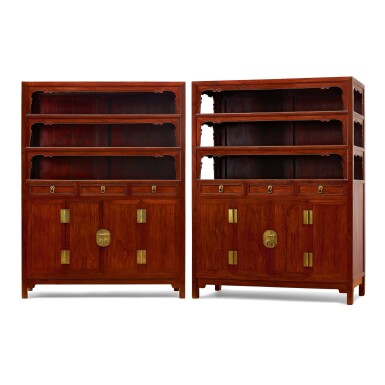
PROPERTY FROM AN IMPORTANT COLLECTION 重要私人珍藏
A RARE AND LARGE PAIR OF HUANGHUALI SQUARE-CORNER DISPLAY CABINETS, WANLIGUI 17TH CENTURY | 十七世紀 黃花梨萬曆櫃成對
Auction Closed
October 9, 06:06 AM GMT
Estimate
4,000,000 - 6,000,000 HKD
Lot Details
Description
Property from an Important Collection
A RARE AND LARGE PAIR OF HUANGHUALI SQUARE-CORNER DISPLAY CABINETS, WANLIGUI
17TH CENTURY
重要私人珍藏
十七世紀 黃花梨萬曆櫃成對
each of massive rectangular form comprised of three sections, the upper section with three open shelves framed by beaded shaped aprons above the middle section enclosing three drawers, the lower section constructed from four framed rectangular panels with the two centre panelled doors opening to reveal one shelf, set with baitong hinges, lobed lockplate and pull handles, all above a plain straight spandrelled apron
141 by 51.8 by h. 193 cm, 55 ½ by 20 ¾ by h. 76 in.
Striking for their imposing size, this pair of cabinets with open shelves demonstrate the exceptional skill of 17th century furniture makers in their ability to take full advantage of the vivid colours and patterns of precious hardwood.
This type of cabinets with multiple open shelves, known as Wanligui (Wanli period cabinets), is highly unusual. First appearing in the mid- to late Ming dynasty, they were generally kept in the scholar’s studio, where their arrangement either side by side or on opposite walls, created a visual symmetry sought after in Chinese room design. The top shelves were used for storing books and scrolls as well as treasured antiques, while writing implements, such as brushes and ink, were kept inside the drawers. The sturdier and enclosed lower were on the other hand, used for storing more fragile objects or tea utensils that could be brought out in the presence of guests. Referred to as lianggegui by modern cabinet makers, this type of bookshelf seldom appears on contemporary woodblock printed books, attesting to its rarity.
The display and storage of books in the scholar’s studio was of great importance as it was indicative of the level of education and cultural refinement of the master of the house. The scholar Gao Lian (1573-1620) in his Zun sheng bajian [Eight discourses on the art of living], first published in 1591, mentions that bookcases “should be used for placing one’s favourite books, which could be Confucian classics, poems, Buddhist scriptures or for important medical literature and calligraphy”. For the Ming dynasty scholar Wen Zhenheng (1585-1645), it was however important not to display too many books and scrolls “otherwise the room looks like a bookstore” (Wen Zhenheng, Chang wu zhi [Treaties on superfluous things], translated in the catalogue to the exhibition Beyond the Screen. Chinese Furniture of the 16th and 17th Centuries, Museum of Fine Arts, Boston, 1996, p. 85).
Cabinets with three open shelves are very rare and no other closely related example appears to have been published. This pair of cabinets share similarities with a smaller cabinet fashioned with two open shelves from the Qing Court collection and still in Beijing, illustrated in Wang Shixiang, Classic Chinese Furniture. Ming and Early Qing Dynasties, London, 1986, pl. 138.
十七世紀,工匠善用佳木良材,依其色澤紋理巧施造化,此對魁碩大櫃便是一例。櫃表紋飾素淨,僅亮格作牙條造型,又鑲銅活,平添趣致。
萬曆櫃為明式家具中之特別種類,因流行於萬曆年間,故名。萬曆櫃結合櫥及櫃之結構,既實用也風雅,深得文人士大夫青睞,常見於文士書齋,或並排左右,或各倚一牆,講求視覺對稱,以合中式屋室陳設之道。櫃頂層格可置書卷,可陳古玩,抽屜則收納筆墨紙硯,下方門櫃牢固,存放待客所用之茶具等易損什物尤宜。萬曆櫃頂設多層格者,稀見無多,而考當時木刻版畫亦鮮見其例,故知珍罕。
書齋內陳列書籍,彰顯主人學識修為,頗受文士看重。明人高濂(1573-1620年)撰《遵生八箋》,萬曆十九年(1591年)初刊,稱書格上應有儒家典籍、釋道名著、詩文名篇、醫散經典、法帖畫卷等。另一學者文震亨(1585-1645年)著《長物志》,強調書齋陳列「不宜太雜如書肆中」,可參考展覽圖錄《屏居佳器:十六、十七世紀中國家具》,波士頓美術館,波士頓,1996年,頁85。
三層萬曆櫃極罕,群書未載其例,惟有一件與此對相類,尺寸較小,設兩層亮格,清宮舊藏,仍貯北京,錄於王世襄,《明式家具珍賞》,倫敦,1986年,圖版138。
